Church Of MO – 2005 Suzuki M50 Boulevard

Recently, we pit the Star Bolt C-Spec against the Suzuki Boulevard M50, in a comparison test. That test was really more an examination of two extremes of cruiserdom rather than a true head-to-head comparison. I bring this up because, as I type this, the Suzuki is currently resting at my abode. I thought nothing of it until I started digging for this week’s Church feature. As you can see from the headline, today’s retrospective is… the 2005 Suzuki M50 Boulevard! So, what has Suzuki done to the M50 in the decade since we first rode one? Not a whole lot, really. Other than a price hike from $6749 to $8599 (which is still pretty affordable, in our opinion), the Suzuki mid-size “muscle” cruiser is pretty much the same. And with that, here’s Gabe Ets-Hokin to describe exactly what that means. Also, don’t forget to visit the photo gallery for even more pics of Gabe and the pocket-size Suzuki.
2005 Suzuki M50 Boulevard
Vrooooom Brappppaaaaaah… That’s the sound of a big 45°, offset crank pin V-twin being revved, the noise echoing off the walls of the urban canyon that is the native habitat of the cruiser rider. The bike he rides is black, has lots of chrome-but not too much, and has the hulking, burly style that we now call a “power cruiser”.
How do I know that? With a laid-back riding position and no windscreen, you’re struggling just to stay on a cruiser at any speed over 70 mph. When the speedometer winds out on a cruiser, my 145 pounds just doesn’t seem like enough weight to hold me down to this planet, I feel like that kitten in the “Hang in there, baby” poster your guidance counselor had hanging in her office.
Since I’m both small and thrifty, I wondered if any manufacturer was going to build a power cruiser for a smaller, more budget conscious rider like me. So I wasn’t completely bummed out when herr magazinenfuhrer Alexander told me to take the horribly rickety and doubtless OSHA-violating MO Van through an hour of rush-hour traffic to retrieve the -new for 2005- Suzuki M50 Boulevard Black.
While waiting in Suzuki’s opulent lobby for my ride, I noticed what seemed like a bewildering array of brochures for different Suzuki cruiser models. Suzuki offers six different standard models, but staggers the consumer with 13 different cruisers, from the miniscule S40 to mighty M95. Why do they name their cruisers with seemingly random numbers and letters?
On closer examination, the system is clearer. “C” denotes classic style (valanced fenders, smaller front wheel), “M” is more of a power cruiser thing, with muscle-bike fenders and cleaner lines than the C models.. “S” denotes a more traditional Japanese cruiser style, harking back to the late ’80s. The number is engine size in cubic inches, as the Japanese have been labeling them for decades. The S40 is the baby of the family and was called a Savage 650 before it was converted. The C50 and M50 are 819 cubic centimeters, followed by the 1,360cc S83, then the 1,470cc C90. At the top of the line, you’ll find the silverback: the M95, with a 1,552cc engine. See? It’s simple once you figure it out.
819cc isn’t a lot compared to some of the mega-cruisers landing (crashing?) on the scene these days, but it wasn’t really that long ago that 819cc was a lot of bike, even for a cruiser. That’s the impression the M50 made on me at first sight- it’s a lot of bike, especially when Suzuki’s press guy is watching to see if you can gracefully roll the thing up into your van.
“So that’s the MO van, eh?” said Suzuki’s press liaison, with a tone one usually uses for describing dead vermin. “I don’t think it’s going to fit.”
I saw what he meant- the MO van has a horizontal divider set up to carry sportbikes, and even a “middleweight” cruiser was just a few inches too long to get the rear doors shut. After some rearranging of the van’s interior, I was on my way back to MO, hoping I had enough remaining brain cells for another hour of carbon monoxide poisoning.
Sportbike Pilot and I unloaded the M50 back at the ranch, and although heavier than most of the sportbikes and standards we’re used to, at a *claimed* dry weight of 540 pounds we noted it wasn’t really that bad. It also has enough ground clearance to use a standard loading ramp without scraping the pipes or frame.
With the bike safely unloaded, we can walk around it and admire the styling. The M50 drips with style, from the slick and first-in-class inverted front forks to the Softtail style rear end. It is low and lean, with plenty of chrome and nice rich black paint. The engine has a lot of black treatment and is surrounded by covers which look like powder coat but prove to be painted plastic covers on closer inspection. The wheels also get the black treatment. Plenty of work has been done on the styling of this bike, and it shows. Suzuki (aside from the S models) has truly come a long way since the Madura, and thank God for that.
The styling flows nicely until we get to the bob-tail rear end, which seems to be a little big for the bike and looks a little disproportionate when compared to the cool black-painted rear wheel. It looks a lot like the tail section of the M95, but on the M50 it doesn’t quite work, especially since the top muffler sticks out so far past the wheel. On the whole, looking at the rear end reminds me of a very small person with freakishly large genitalia, although Maximum MOron Sean really dug the rear end’s styling. Then again, he also likes midget porn.
With that thought planted firmly in my subconscious, it was now time to suit up and head to Santa Monica for an initial riding impression. First, we have to play the motorcycle tester’s favorite game, “where’s the ignition?”. On some cruisers, this can provide a few minutes of diversion, but the M50 has it sensibly located out in the open on the right side of the steering head (God forbid they put it someplace garishly practical, like on the upper triple clamp -Sean).
The engine fires up instantly, with just a hint of engineered-in balkiness. There’s no choke with Suzuki’s new AFIS: Auto Fast Idle System. Suzuki likes acronyms. What you also notice right away is the sound- it’s got an authentic potato-potato v-twin rumble, and it sounds quite nice. The bike is ready to ride instantly, so I reach for the chrome bars and hoist the bike upright.
The bike’s centre of gravity feels very low, and of course it has a short seat height, so I’m not intimidated. I wave my left foot around, feeling for the footpeg and gearshift, and find them in a very-forward position, as today’s cruiser riders demand. I snap it into gear, and release the smooth clutch while twisting the fat throttle.
Rolling into traffic, I notice the nice switchgear, encased in aluminum-look control pods. There is a Euro-style passing light (to coax S40s out of the way, I guess) and even a hazard flasher in case you notice a rapidly-closing M95 in your mirrors.
Don’t get M95 envy though, as the M50 has some very nice thrust off the line. The five-speed gearbox works smoothly, and the new-fangled Suzuki Dual Throttle Valve System (SDTV, just like a GSX-R -Sean)-equipped fuel injection means I can leave it in second, or third to troll around town. As you roll into the throttle, acceleration presses you down into the small, well shaped saddle and you struggle to keep a grip on the high bars. Strapping the M50 onto MO’s Dynojet revealed two things: one, the liquid cooled, four-valve per cylinder motor pumps out 44.09 hp and 42.83 foot-pounds of torque [See Chart.]. Two, you shouldn’t feed the Executive Editor cheese curls when they are dyno-testing.
It may have a little price and be light for a cruiser, but it feels big on power and has a commanding presence.
This bike has such a smooth, responsive motor that it’s fun to dart in and out of traffic by just rolling on and off the throttle. The wide bars, low center of gravity and relative light weight (for a cruiser!) gives you way more confidence than you’d expect from a near-600 pound bike in this environment. Urban traffic is what this bike is designed for and it is indeed lot of fun around town.
Riding onto the freeway is fun as well- the pegs are far forward, but they are pretty high as well, so cornering clearance is impressive (for a cruiser!). So you can lean it over farther than most large cruisers, allowing you to negotiate long, sweeping onramps confidently, without raising a shower of sparks like a floorboard equipped heavyweight might. Once you’re around the onramp, the smooth clutch, gearbox and burly little motor get you up to illegal speeds in no time.
But then it’s not as fun over 70 MPH. Windblast is tolerable over 60, but the feet-forward riding position is unsuitable if the cuffs are open on your jeans, as wind rushes up your legs and tries to pull your feet off the pegs. In the meantime, your ass starts to hurt after 20 minutes, since all your weight is resting on your tailbone.
However, freeway droning is not why we buy cruisers, right? They are for trolling the boulevards, and the occasional jaunt on a twisty road. When it comes to a jaunt, you should be able to go about 110 miles before the reserve lamp comes on. My mileage averaged around 35 mpg with a combination of freeway riding, trolling city streets, and Cheetos ™-chewing dyno runs.
On my second day with the M50, I took it out on some local twisties to get a feel for the handling. The M50 Boulevard is a power cruiser, and that means some suspension credibility and handling prowess is needed along with extra power. The M50 does more than look the part, with beefy 41mm inverted forks up front- the first in this category. They do a good job of providing feedback and holding the bike on the desired line in sweeping turns.
I just wish the rear end of the machine was as good as the front. I used to have a 1970 Datsun 1600 roadster, which was mechanically a copy of a 1950’s era MG-A. This meant it had sophisticated for 1960 coil springs on the front wheels, but a sacked-out leaf spring and live axle in the rear. It would track smoothly over bumps on the freeway with the front wheels, but then bounce you out of your seat as the front of the car dragged the rigid rear end over the obstacle.
That’s what a shaft-driven cruiser is like. To reduce the shaft-jacking effect and to keep the seat height super-low, (as the Great Consumer-Gods demand) the rear shock must have short travel and a stiff spring. So when you hit a bump, the bike basically bounces over it like a Flexible Flyer pulled by a hyperactive five-year old. Did I mention my ass is sore? And not because of the MO “initiation” party, either. If you plan to buy a shaft-drive cruiser, you should slow down for potholes, expansion joints, and speed bumps. You might also want to look in Grandpa’s closet for a kidney belt.
A 170/80-15 IRC Grand High Speed tire provides adequate grip and feel. Most importantly, it gives us that fat rear tire look without making the bike heavy to steer. The front tire is also a Grand High Speed, in the classic 130/90-16 size. I think the touring tire size on the Power Cruiser front end is a little mismatched, but it looks nice enough and handling doesn’t seem to be compromised by it. It should last a good long time, but I would want to replace it with something a little grippier, if such a thing exists in this size.
On smooth pavement, the M50 is great, really reminding me what is attractive about cruisers. The exhaust fills the air with a healthy blatting noise, the tiller-like bars toss the bike into bends easily enough, and you can enjoy surfing the smooth little wave of torque served up by the silky, well-carbureted engine.
Is the moto-nirvana promised by a low-maintenance shaft drive negated by the bobbing and jouncing delivered by the driveshaft shoving the bike into the air every time you get on the gas hard? I rode a shaft-drive BMW for many years, and you do get used to it. But it’s noticeable. You just have to ride more smoothly and pick your lines through turns carefully: rolling off the throttle mid-corner will cause a little wobbling and bouncing as the back of the bike drops and takes the weight off the front end.
Another area you will have to be careful with is the brakes. Once again, I am exposed to our good friend the two-piston, sliding-pin caliper, (TPSPC) circa 1982. It requires the typical manly five-fingered squeeze on the front brake lever and has the customary wooden feel. The rear brake is handled by a drum- yes a drum! How quaint (That’s “authentic” retro technology! -Sean)!
But it works well enough: on cruisers the weight is biased towards the back, which lets the rear tire really bite down on the blacktop. Though it may be a low-tech drum, the rear brake can lock the tire with a hefty shove on the pedal, rewarding the rider with a cool screeching sound and a little puff of white smoke. Combined with the M50’s relatively low weight and intended audience, the brakes should prove to be adequate.
Motor, brakes, suspension, almost everything is nicely chosen for this bike. It works quite well as a package. The exhaust sounds great, it’s not too heavy for fun on twisty roads but not too light for freeway cruising and general self-esteem. The exhaust sounds terrific, the motor feels plenty strong and the fuel injection is pretty much faultless.
Sure, the rear suspension and brakes aren’t up to today’s standards, then again few cruisers are. This is not a big-buck trailer queen or racer-boy fantasy bike. It’s designed for the everyday rider to transport him or herself to work or school on. The majority of these will live hard, neglected lives by riders who will never even get close to the machine’s performance limits. These customers simply want style and value, lots of it.
Value is the M50’s best feature. For $6,749 you can buy a very high quality cruiser with a unique look and great sound at a price point below that of its competitors, some of which have not been redesigned for many years. The M50 will impress a seasoned rider and make a new or re-entry rider think they’ve died and gone to moto-heaven.
| ** Specs Provided By Suzuki ** | ||
| Engine: | 50 cubic inch, four-stroke, liquid cooled, 45 degree V-twin, SOHC, 8-valves, TSCC | Key FeaturesSuzuki Boulevard M50 is styled with a sleek, muscular look combined with advanced Suzuki technology and features Engine Features Fuel-injected, 50 cubic inch, eight-valve, liquid-cooled, 45 degree V-twin engine tuned for exceptional low rpm power and torqueGSX-R-derived electronic fuel injection system features the Suzuki Dual Throttle Valve System (SDTV) – maintains optimum air velocity in the intake tract for smooth low-to-mid rpm throttle response and high torque output – includes Auto Fast Idle System (AFIS)32-bit ECM provides precise control of ignition timing and multi-hole-type injectors ensuring quick startup and excellent drivability under all conditionsFuel injection system receives input from gear position sensor, water temp. sensor, air temp. sensor and intake port sensors for efficient power delivery and better fuel economyCrankshaft designed with 45° offset crank pins to reduce engine vibration without a counterbalancer for a more comfortable rideFive-speed transmission features a high fifth gear ratio for relaxed highway cruisingLow-maintenance shaft final-drive system is clean-running with low torque reactionCustom-styled exhaust designed for a deep rumbling sound and tuned low rpm powerPulsed-secondary air-injection system introduces air into the exhaust ports to ignite unburned hydrocarbons and reduce emissions – CA. spec. model is equipped with a catalyst for further emission reductionChassis Features Soft-tail-style frame creates a continuous flowing line from the headlight, through the fuel tank, seat and rear fenderSharp-edged-styled front fender adds to the clean look of the front end, while the bob-tail rear fender adds to the flowing lines at the rearHandlebar-mounted speedometer styled for a clean appearance and positioned for good visibilityWide, comfortable seat with low seat height – passenger seat can be removed for a bobbed rear fender appearanceLow-rise handlebars mounted on pull-back risers provide a comfortable reach for the rider and increased comfort around town or on the highwayInverted, 41mm front fork for a performance look and comfortable ride – the only model in the class with an inverted forkLink-type rear suspension connects to a truss-style swingarm and a single shock absorber with 7-way spring preload adjustmentLarge LED-type taillight with a clear lens provides a modern custom lookPowerful multi-reflector headlight housed in an attractive case with stylish headlight rim – headlight switches off during startup to reduce load on batteryBright bullet-style turn signals designed for high visibility and attractive appearanceStandard 4-way emergency flasher and high-beam passing switchBlack cast aluminum rims carry a wide 130/90-16 front tire and 170/80-15 rear tireSingle front disc brake with large 300mm rotor and 180mm rear drum brake for strong braking performanceOptional accessories WindshieldLight BarSaddlebagsEngine GuardsSpecialLong, wide 4.1 gallon fuel tank flows smoothly back to the seat -attractive raised fuel filler includes indicator lights for turn signals, high beam and low fuel |
| Bore Stroke: | 83.0 x 74.4mm | |
| Compression Ratio: | 9.4:1 | |
| Fuel System: | Electronic Fuel Injection | |
| Lubrication: | Wet Sump | |
| Ignition: | Digital | |
| Transmission: | 5-speed | |
| Final Drive: | Shaft Drive | |
| Overall Length: | 2370mm (93.3 in.) | |
| Overall Width: | 860mm (33.9 in.) | |
| Overall Height: | 1130mm (44.5 in.) | |
| Seat Height: | 700mm (27.6 in.) | |
| Ground Clearance: | 140mm (5.5 in.) | |
| Wheelbase: | 1655mm (65.2 in.) | |
| Claimed Dry Weight: | 245kg (540 lbs.) | |
| Suspension Front: | Inverted, telescopic, coil spring, oil damped | |
| Suspension Rear: | Link-type, oil damped, 7-way adjustable spring preload | |
| Brakes Front: | Single hydraulic disc | |
| Brakes Rear: | Single drum | |
| Tires Front: | 130/90-16 | |
| Tires Rear: | 170/80-15 | |
| Fuel Tank Capacity: | 15.5 liter (4.1 gal.) | |
| Color: | Blue, Red | |

Troy's been riding motorcycles and writing about them since 2006, getting his start at Rider Magazine. From there, he moved to Sport Rider Magazine before finally landing at Motorcycle.com in 2011. A lifelong gearhead who didn't fully immerse himself in motorcycles until his teenage years, Troy's interests have always been in technology, performance, and going fast. Naturally, racing was the perfect avenue to combine all three. Troy has been racing nearly as long as he's been riding and has competed at the AMA national level. He's also won multiple club races throughout the country, culminating in a Utah Sport Bike Association championship in 2011. He has been invited as a guest instructor for the Yamaha Champions Riding School, and when he's not out riding, he's either wrenching on bikes or watching MotoGP.
More by Troy Siahaan




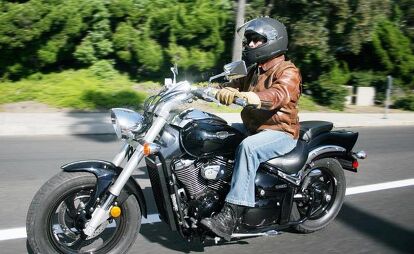











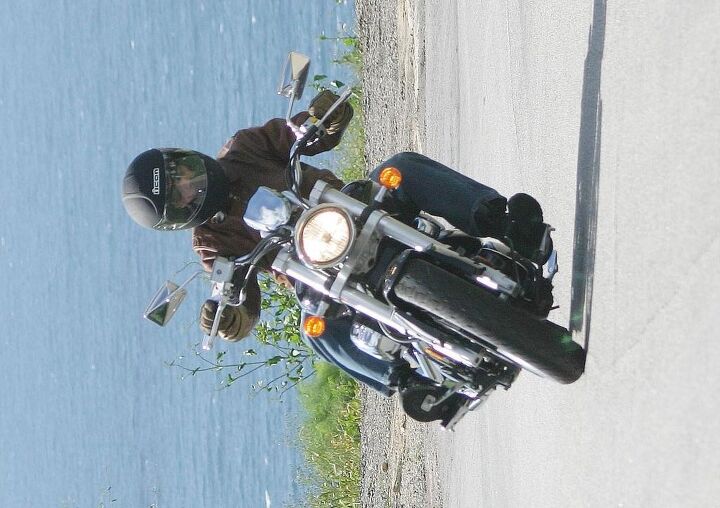

















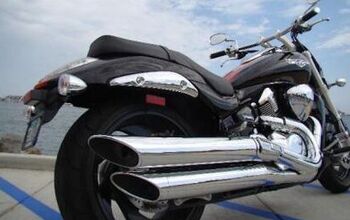
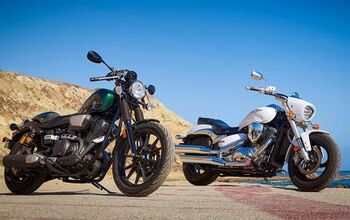
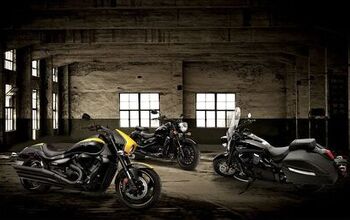












Comments
Join the conversation
Why do you guys keep reposting reviews of weedy, uninteresting metric cruisers for Church of MO? I started following this series because you were sharing wacky and interesting reviews from your archives, not because I was curious as to how you received a bunch of execrable Japanese Harley knockoffs ten years ago.